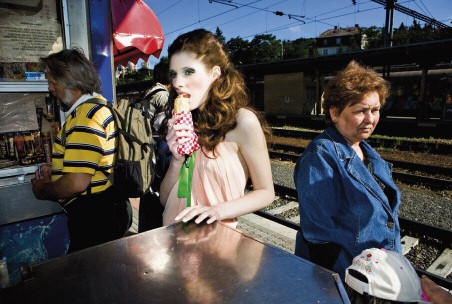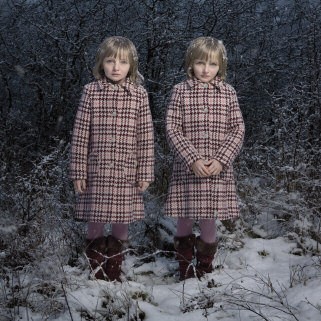Lyon septembre de la photographie – fotografické září v Lyonu
Photography from the post-Communist countries of Central and Eastern Europe enjoyed a brief moment as the highlight of attention shortly after the fall of the Berlin Wall, when museums and galleries as well as festivals of photography from Houston to Arles competed as to who would present works from this region first and in the broadest scope. Today, alongside the traditional photographic superpowers such as the United States, Germany, UK and France, there stands at the center of attention photography from Japan, China, Korea, or South America. With the exception of Russia, Central and Eastern European photography features at major photography festivals in Western Europe or in the United States only sporadically. The autumn of 2008 presented one such exception, when the Dutch Noorderlicht Festival focused on the photography of the former Soviet Bloc (with the exception of Russia itself), and also when photography from the Czech Republic, Slovakia, Bulgaria and Serbia featured in abundance at the 5th edition of the international festival Lyon Septembre de la photographie held in France’s second city (though it must be said that Lyon has long competed for this honor with Marseilles).
In spite of the festival’s modest budget, a small team of organizers headed by Gilles Verneret managed to present in Lyon between mid- September and the end of October forty-five separate exhibitions, as well as to hold a three-day international symposium, publish an extensive catalogue of 169 pages in both French and English, and invite a number of foreign guests. The picturesque historical center of Lyon with its countless cafes, pubs and galleries moreover provided the festival with a most agreeable setting. The friendly atmosphere and informal socializing reminded one more of Arles, Perpignan or Brag, than of the festivals held in large cities which are often crowded by dozens of other events. Moreover, Lyon’s Septembre de la photographie also enjoyed a good level of promotion: posters featuring the photograph Chlupatá (Fluffy) by Barbora Bálková could be seen on every corner, and festival events received extensive coverage in the media.
The main theme of the festival was identity, to which most exhibitions in the official program were dedicated. Among them was also an exhibition of young Czech women photographers, entitled Identity and presented in two parts: in the gallery of the Municipal Library, and in the exhibition hall of the regional artists’ organization M.A.P.R.A. This featured a broad spectrum of approaches and styles. In her cycle Refugees, Kateřina Držková interlinked the theme of change in identity with the theme of political and economic migrants, who have in recent years started to arrive in the Czech Republic, a fairly homogeneous country in terms of ethnicity. With the aid of a computer, she visualized the dreams of foreign refugees, creating for them a far more glamorous world than the actual refugee camps where they live at present. In her cycle Self-Portraits with Men, Dita Pepe captivated audiences with her ability to completely identify with the men at her side, changing everything about herself apart from the underlying features of her face. Her photographs speak volumes not just about contemporary men, but about our society in general. In her cycle Masks Barbora Bálková portrayed the face of a single woman with a number of unconventional masks. Similar to the work of the Surrealists, Diane Arbus or Joel Peter Witkin, she shows that people change their identity through the use of masks, becoming someone else, the mask both concealing and revealing their inner self. Similar themes also appear in the trios of portraits entitled Potomci (Descendants), in which Barbora Žůrková in collaboration with her husband Radim Žůrek computer-generated the faces of fictitious progeny, in whose features her genes are combined with those of various men. In her Portréty žen (Portraits of Women) Sylva Francová used a computer to combine shots of various everyday situations, thus creating a many-sided view on her closest relatives and friends, in which reality was merged with both arrangement and subsequent manipulation. The cycle shows that each person has many different faces, and plays several different roles in his or her life. In her enigmatic portraits of reallife twins as well as computer-generated clones of young girls, Tereza Vlčková attempted to explore the identities of people whose physiological kinship was the closest possible, and whose outward similarity of appearance is enhanced further by identical attire and hairstyle. In the subtle contrasts and analogies of their facial expressions, which were surprisingly mature, the artist accentuates questions as to whether their psyches and character were actually so close, what were their mutual relationships, their alter egos, how many faces are hidden in each of us. The exhibition also included images concerned with more general social issues of the changing roles of people in the globalized world of our time (Daniela Dostálková, Štěpánka Stein with Salim Issa, Barbora Mrázková with Filip Láb) as well as the more symbolic works of Barbora Kuklíková, inspired by Gothic novels and horror films. The Czech exhibition was warmly received in Lyon. Even though the festival included exhibitions by such famous artists as Raymond Depardon and Martin Parr, the jury awarded the BMW Prize for Best Artist to Tereza Vlčková, and the shortlist also included Dita Pepe.
Czech photography was also represented in Lyon by the portraits of weeping politicians by Jiří David, which formed part of the exhibition of current tendencies in portrait photography held at the Musée de l’Elysée in Lausanne, and the solo exhibition of Kateřina Držková featuring her conceptual series Pohledy and its confrontation of different variants of picture postcards featuring identical motifs. Slovak photography was also well-represented, although it was difficult to find any unifying concept in the selection of the artists as such. The Slovak scene was represented by Martin Kollár and Dana Kaprálová with their subjective documentary pictures of various absurd motifs of everyday life, Andrej Balco’s comparative portraits of Brazilian man- and maid-servants with their affluent employers, Pavel M. Smejkal’s photomontages of contemporary celebrities in the place of prisoners interned in concentration camps, and finally several cycles of Jana Hojtričová, with her gender-conscious motifs of the female body. To a smaller degree, the Lyon festival also managed to present photographers from other post-Communist countries, such as Bulgaria’s Vesselina Nikolaeva, whose photographs from a school in Sofia amply illustrate the new lifestyle of Bulgarian youth, or Serbia’s Paula Muhr, whose exhibition struck one above all through the pairings of old amateur snaps of her mother, and her present-day portraits.
Among the most attractive parts of the festival was the exhibition of photographs of the National Foundation of Contemporary Art, which alongside the work of world-famous photographers such as Martin Parr or Beat Streuli, also prominently featured the compelling 1950s sociological portraits of Virgilio Vietez, oscillating between Sander’s interwar work and Italian Neorealist cinema. Also striking was the comparison of pictures of early 20th century beauty queens and portraits of ninety-year old women by the Dutch photographer Annet van der Voort, or the spectral images of urban landscapes of Odessa, Sarajevo, Las Vegas, and other cities by Monique Deregibus. The festival program also included several blunders, such as a series of utterly banal portraits of aged singers and actors by Christian Buffa (the arbitrariness and lack of concept in these snaps were also illustrated by his clueless presentation at the symposium in theory). I regard the highlight of the festival to have been the outstanding exhibition of recent graduates of the National School of Photography in Arles, prominent among which were the technically brilliant nocturnal images of Olivier Metzger, charged with content and reminiscent of the atmosphere of the films of David Lynch; the fascinating portraits of young women by Caroline Chevalier; and the no less powerful exhibition of Rip Hopkins with his uncommonly resourceful self-portraits, casting himself in the roles of members of various social groups and participant in the strangest scenes. Lyon’s Septembre de la photographie has unquestionably succeeded in winning a foremost place among the dozens of photography festivals taking place in France.
#12 Reconstruction
Archive
- #45 hypertension
- #44 empathy
- #43 collecting
- #42 food
- #41 postdigital photography
- #40 earthlings
- #39 delight, pain
- #38 death, when you think about it
- #37 uneven ground
- #36 new utopias
- #35 living with humans
- #34 archaeology of euphoria
- #33 investigation
- #32 Non-work
- #31 Body
- #30 Eye In The Sky
- #29 Contemplation
- #28 Cultura / Natura
- #27 Cars
- #26 Documentary Strategies
- #25 Popular Music
- #24 Seeing Is Believing
- #23 Artificial Worlds
- #22 Image and Text
- #21 On Photography
- #20 Public Art
- #19 Film
- #18 80'
- #17 Amateur Photography
- #16 Photography and Painting
- #15 Prague
- #14 Commerce
- #13 Family
- #12 Reconstruction
- #11 Performance
- #10 Eroticon
- #9 Architecture
- #8 Landscape
- #7 New Staged Photography
- #6 The Recycle Image
- #5 Borders Of Documentary
- #4 Intimacy
- #3 Transforming Of Symbol
- #2 Collective Authorship
- #1 Face





